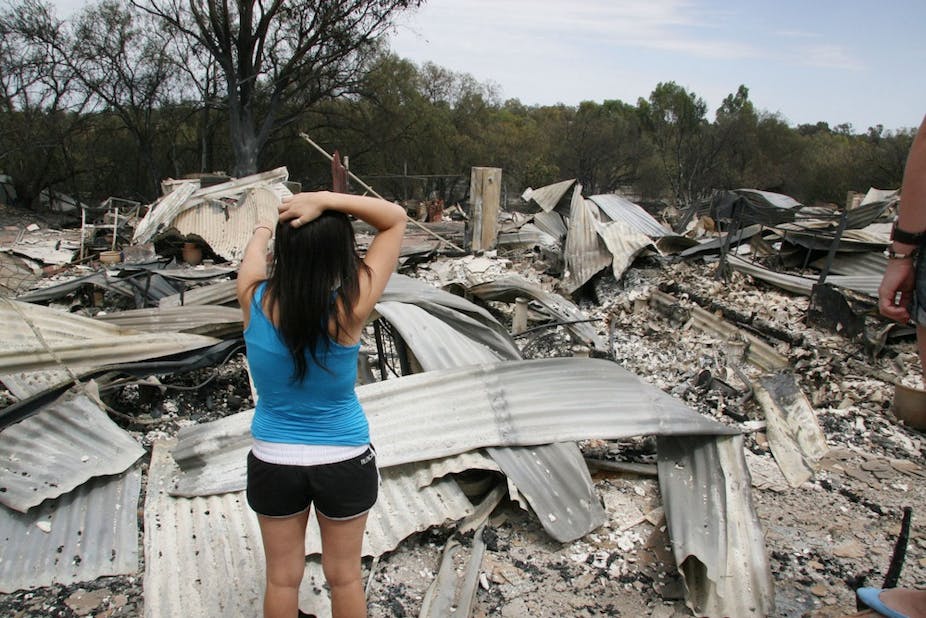Australia has an unprecedented opportunity to resolve issues of escalating insurance prices caused by an uncertain climate. The time has come to curb the trend towards increased economic exposure to natural catastrophes.
The recent change of government, the upcoming Australian G20 in Brisbane in 2014, the establishment of the Bushfire and Natural Hazards Research Centre and international support from APEC finance ministers all point towards support for research and action for disaster risk financing.
Disaster risk financing is defined as strategies and instruments used to manage the financial impact of disasters. Disaster risk financing can use mechanisms like budgetary reallocation, debt financing, increased taxation or international aid. Or there are ex ante mechanisms, such as government reserves, insurance, contingent credit or catastrophe-linked securities.
The impetus to develop this kind of financing in Australia has its basis in a number of reports outlining existing inadequacies, including the Victorian Royal Commission final report into the 2009 Black Saturday bushfires and the Natural Disaster Insurance Review in the wake of Queensland’s floods and and Cyclone Yasi. Subsequent reports have affirmed the need for insurance in Australia to be the “key instrument that supports any efforts to maximise national resilience”.

Research abounds concerning the need to implement preferable solutions to the increasing number of catastrophic events, particularly in relation to improving access and affordability of insurance products. Insurance can play a pivotal role in the financial component of disaster risk management, reducing the financial, fiscal and economic impact of disasters as well as promoting faster disaster recovery.“
In 2013, the Productivity Commission highlighted that tackling these issues was essential to remedying negative economic consequences from weather-related phenomenon. At present, natural disasters have a big impact upon the Australian economy incurring losses for property, infrastructure, business interruption, supply of raw materials and commerce.
In 2012 a Lloyds Report on underinsurance, estimated the average insurance gap in Australia for each catastrophic event as more than A$0.83 billion. The insured portion of losses is generally only 49.9%, leaving a large proportion of uninsured losses. This poses the questions about the best means of financing the entire issue disaster risk.
In 2012 the Australian Business Roundtable for Disaster Resilience and Safer Communities found the total economic cost of natural disasters in Australia is estimated to have exceeded A$6 billion. Further, these costs are expected to double by 2030 and to rise to an average of A$23 billion per year by 2050.
These costs are rising at alarming rates and cannot simply be ignored.
The Australian Treasury has positioned macroeconomic policy as a key discussion area for the Australian G20. Given the economic and social impact of natural disasters across Australia recently, it would be logical to incorporate disaster risk financing into such discussions.
The G20 even has a Methodological Framework of suggested approaches to disaster risk financing. This framework could be adapted to Australia’s unique geopolitical environment.
But while disaster risk financing was first incorporated into the G20 agenda in 2012 during the Mexican presidency and continued under the APEC Presidency in 2013, it has not yet been placed as a key item of concern on the Australian G20 agenda.

Karl Sullivan, General Manager of Policy Risk and Disaster at the Insurance Council of Australia has suggested the G20 could be utilised as a "forum where ideas and best practices are shared… tailoring approaches to the specific needs of disaster risk at a national level, addressing what the economy can put up with and dealing with the issue of cultural awareness”.
Australia is not the only country that could benefit from disaster risk financing being included on the G20 agenda. In September, the APEC financial ministers urged the need to:
…intensify individual efforts to introduced best practise in disaster risk financing, including fiscal contingency planning and developing risk transfer instruments available through insurance and capital markets… look[ing] forward to more experience sharing, with the help of the OECD, the Asia Development Bank (ADB), the World Bank, and the relevant international organisations, to explore effective approaches that can facilitate the implementation of key priorities.
Australia should thus heed this warning. In the words of former Justice Michael Kirby, “until Australians face up to the necessary tough decisions, they will be condemned, on a regular cycle, to witness further Ash Wednesdays, Black Saturdays and flames, floods and tempests on every other day.”

